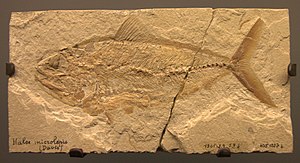Halecidae
| Halecidae | ||||||||||||
|---|---|---|---|---|---|---|---|---|---|---|---|---|

95 million year old Halec microlepsis fossil from Lebanon. |
||||||||||||
| Temporal occurrence | ||||||||||||
| Cenomanium to Turonium (Upper Cretaceous) | ||||||||||||
| 100.5 to 89.7 million years | ||||||||||||
| Locations | ||||||||||||
|
||||||||||||
| Systematics | ||||||||||||
|
||||||||||||
| Scientific name | ||||||||||||
| Halecidae | ||||||||||||
| Agassiz , 1834 |
The Halecidae are an extinct fish family from the order of the lizard fish relatives (Aulopiformes) that lived in the Upper Cretaceous.
features
In contrast to almost all recent and also most of the extinct lizardfish relatives, the Halecidae are not very slender, elongated fish, they rather resembled herring or salmon -like herring in their shape . They were small to medium-sized fish, 5 to 20 cm long. The dorsal fin was in front of the middle of the body, opposite the pelvic fins. The caudal fin was forked or more or less clearly indented. The mouth was large and deeply split.
Genera
So far 3 (or 4) genera have been described.
- Halec (3 types)
- Hemisaurida (2 species)
- Phylactocephalus (1 species)
- Serrilepis (affiliation disputed)
Systematics
The Halecidae are assigned by Joseph Nelson and Karl Albert Frickhinger to the suborder Halecoidei within the Aulopiformes (lizard fish relatives). Other scientists assign all Cretaceous lizardfish relatives to the suborder Enchodontoidei, which, however, is not monophyletic .
literature
- Karl Albert Frickhinger: Fossils Atlas Fish , Mergus-Verlag, Melle, 1999, ISBN 3-88244-018-X .
- Joseph S. Nelson : Fishes of the World. 4th edition. John Wiley & Sons, Hoboken NJ et al. 2006, ISBN 0-471-25031-7 .
- Hilda MA Silva; Valéria Gallo: Taxonomic review and phylogenetic analysis of Enchodontoidei (Teleostei: Aulopiformes). Anais da Academia Brasileira de Ciências ISSN 0001-3765 doi : 10.1590 / S0001-37652011000200010